Whose Epic Is It Anyway?

By Asavari Singh
Contributor
11/4/2021
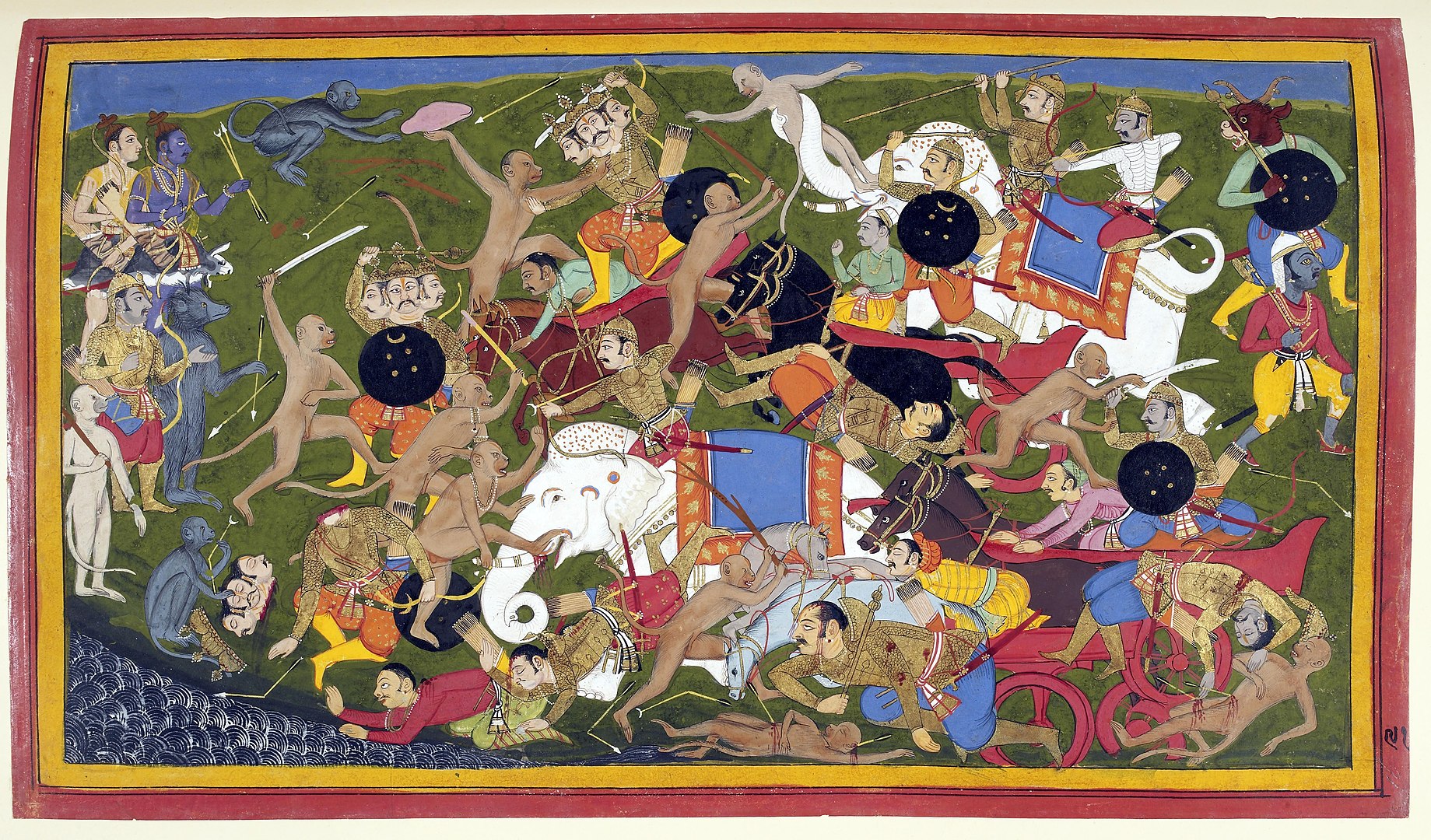
Scene from the Ramayana depicting a battle between Rama and Ravana’s forces
In India, it’s often said that what is not found in the great ancient epic Mahabharata can be found nowhere else. But if it’s found in the Mahabharata, it can be found elsewhere as well. Similar beliefs are also held about the other great ancient epic, the Ramayana. Indians take great pride in the influence these epics have had on surrounding cultures in Southeast and East Asia via traders, monks, wandering mendicants, and, later on, Bollywood. They are pleased when they are told that the monkey king Sun Wukong from the classic Chinese novel Journey to the West was inspired by Hanuman, an important character who appears in both Indian epics. Or how the stunning Khon and Lakhon dances of Thailand are re-enactments of the Ramayana. Or how, at some point at least, Indonesia loved tv shows based on the Mahabharata. Yet, in the past few decades, many Indians have grown possessive over the epics. There are informal but obvious strictures about who in the country can talk about the epics, and what they can say and what they can’t. Ironically, fidelity is demanded not to the ancient texts themselves, as much as to the wildly popular tv adaptations.
First things first, few people in India, apart from scholars and the most devout, actually read the Mahabharata and Ramayana in their entirety. It’s easy to see why.
The traditional Sanskrit version of the Mahabharata, attributed to the sage Vyasa, is the longest poem ever composed. It’s by some rough estimates 15 times longer than the Bible, eight times the combined length of the Iliad and the Odyssey. Believed to have been compiled between the 4th century BC and 4th century AD, it overflows with gods, demons, kings, queens, sages, family feuds, philosophical discourses, religious scriptures (including the famous Bhagavad Gita or “Song of God” so loved by international management gurus), theories of war and statecraft, plots within plots, stories within stories, even its own telling of the Ramayana. It’s easy to get lost in it, but distilled to its barest essence it tells the story of the five heroic Pandava brothers and their moral dilemmas as they feud with their unpleasant cousins, the Kauravas. The Pandavas’ ally is Krishna (an incarnation of the divine Vishnu, the protector of the universe) who imparts nuanced lessons, amid a grand battle, on the paramountcy of duty (dharma), truth, and ethics.
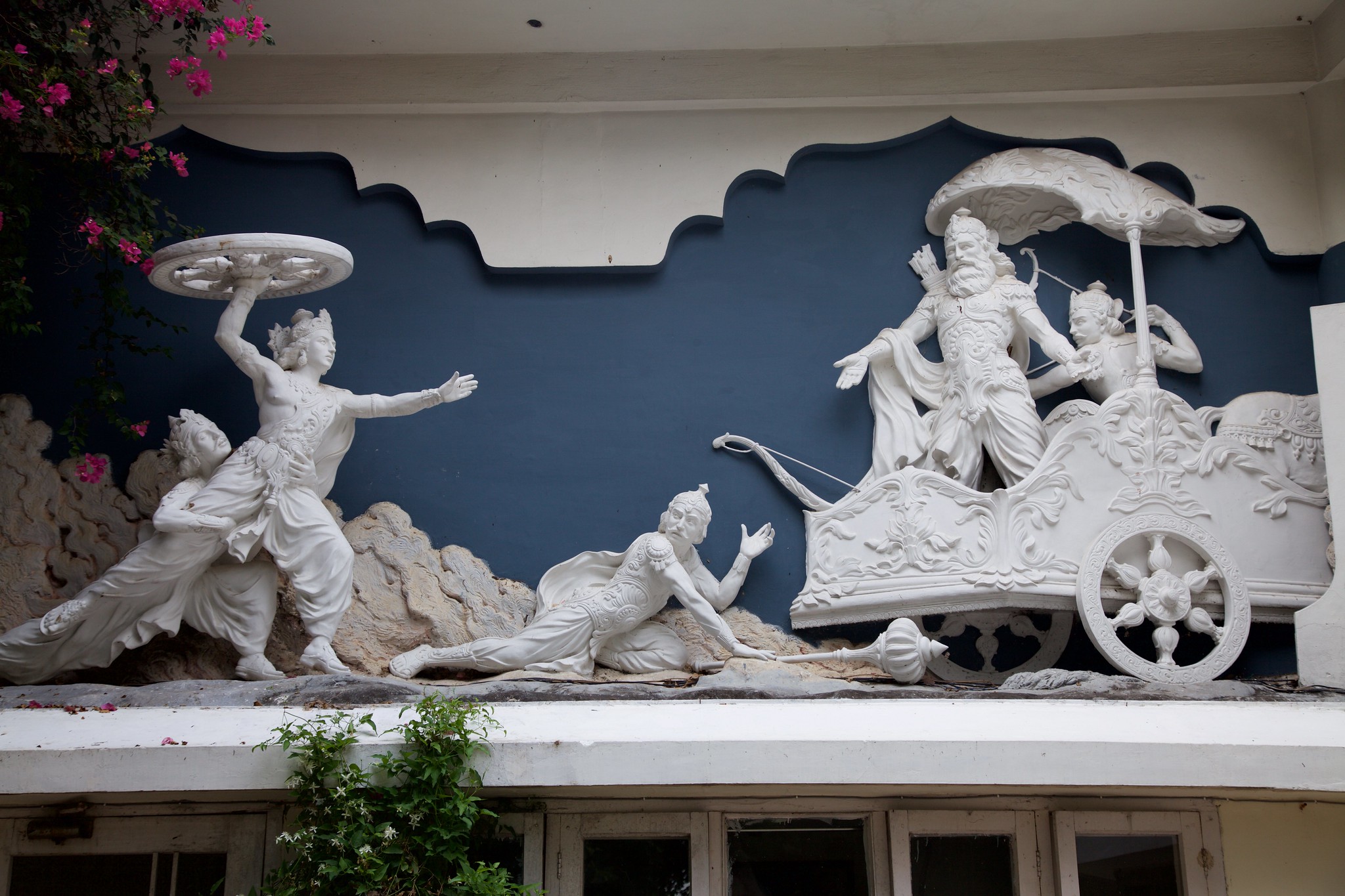
Sculpture depicting a scene from the Mahabharata in which Krishna aims his deadly “sudarshan chakra” (wheel) at Bhishma, commander of the Kaurava army (Picture Credit: Richard Friedericks)
The Ramayana is not quite so colossal, but it’s no lightweight either. The “original” Sanskrit version is ascribed to the seer Valmiki and dated at around the 5th century BC; another dominant version of the story is the 16th-century Ramcharitmanas by Tulsidas. There are some differences in both versions but the central themes are the triumph of good over evil, the path of righteousness, and the nature of true love, whether conjugal, filial, or fraternal. The main protagonist is Rama, the virtuous prince of Ayodhya (and the seventh human incarnation of Lord Vishnu), who is exiled to a forest for 14 years on the eve of his coronation because his stepmother wants her son on the throne instead. He leaves without fuss and with his wife Sita and brother Laxman, traversing unforgiving lands and bringing down form-changing rakshasa (demons). Then, in the last year of exile, the 10-headed rakshasa Ravana kidnaps Sita and takes her to his kingdom, Lanka. The monkey king Hanuman and his army of simians join Rama and Laxman on their quest to rescue Sita. They defeat the demons, Sita proves her chastity in a trial by fire, and Rama is crowned king of Ayodhya – but it is not all happily ever after. People start questioning whether, in fact, Sita is still chaste and a worthy consort for Rama. She is thus exiled from the kingdom again and gives birth to her twin sons in the forest where Valmiki (the purported author of the Ramayana) also stays. Her sons, Luv and Kush, hear the saga from Valmiki who also tutors them to become great warriors. When they grow up, they defeat Rama’s kingdom. They end up reconciling with their father but when Rama asks her to prove her chastity again Sita descends into the earth and the distraught Rama relinquishes his worldly existence too and walks into a river.
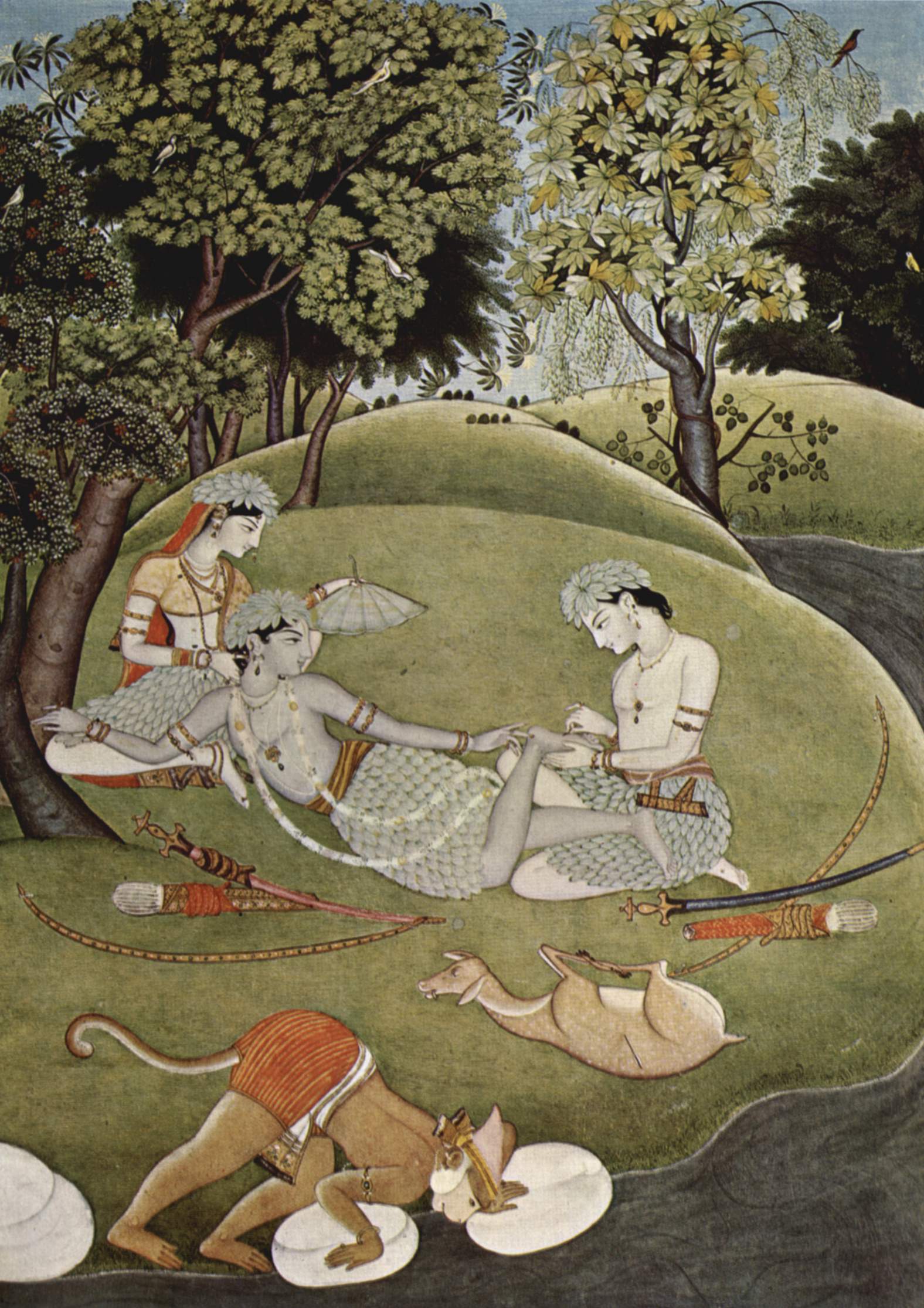
Rama, Sita, and Laxman in exile in the forest
Such synopses, of course, do scant justice to the cultural forces that are the Mahabharata and Ramayana. They cannot even be compared to the “classic books” of the West, static things that become a preserve of the intellectual elite and gather dust on shelves. The urtexts – the “original” written stories — were always kind of beside the point. Through the centuries, people in India imbibed the stories and teachings of these epics by cultural osmosis: through paintings, through narrative sculptures carved intricately on temple walls, through festivals, through dance-dramas, through song, through languid storytelling sessions on grandma’s lap.
It was only natural, then, that the epics would adapt to new mediums and come to the tv screen, and so they did to resounding success – first the Ramayana (1987-88) and then the Mahabharata (1988-90). Both tv serials aired once a week on the state-run (and, back then, only) channel Doordarshan, to record viewership. Shops would be shuttered, stoves would be switched off, and a reverential hush would fall as the entire household – old and young, masters and servants – would gather for the 45 minutes they’d been waiting for all week. These were not just “watch parties” but religious rituals – to many people, each airing of the Ramayana, especially, was akin to receiving a blessing from Lord Rama himself, and was thus preceded by lighting a stick of incense and placing ceremonial marigold flowers on the tv.
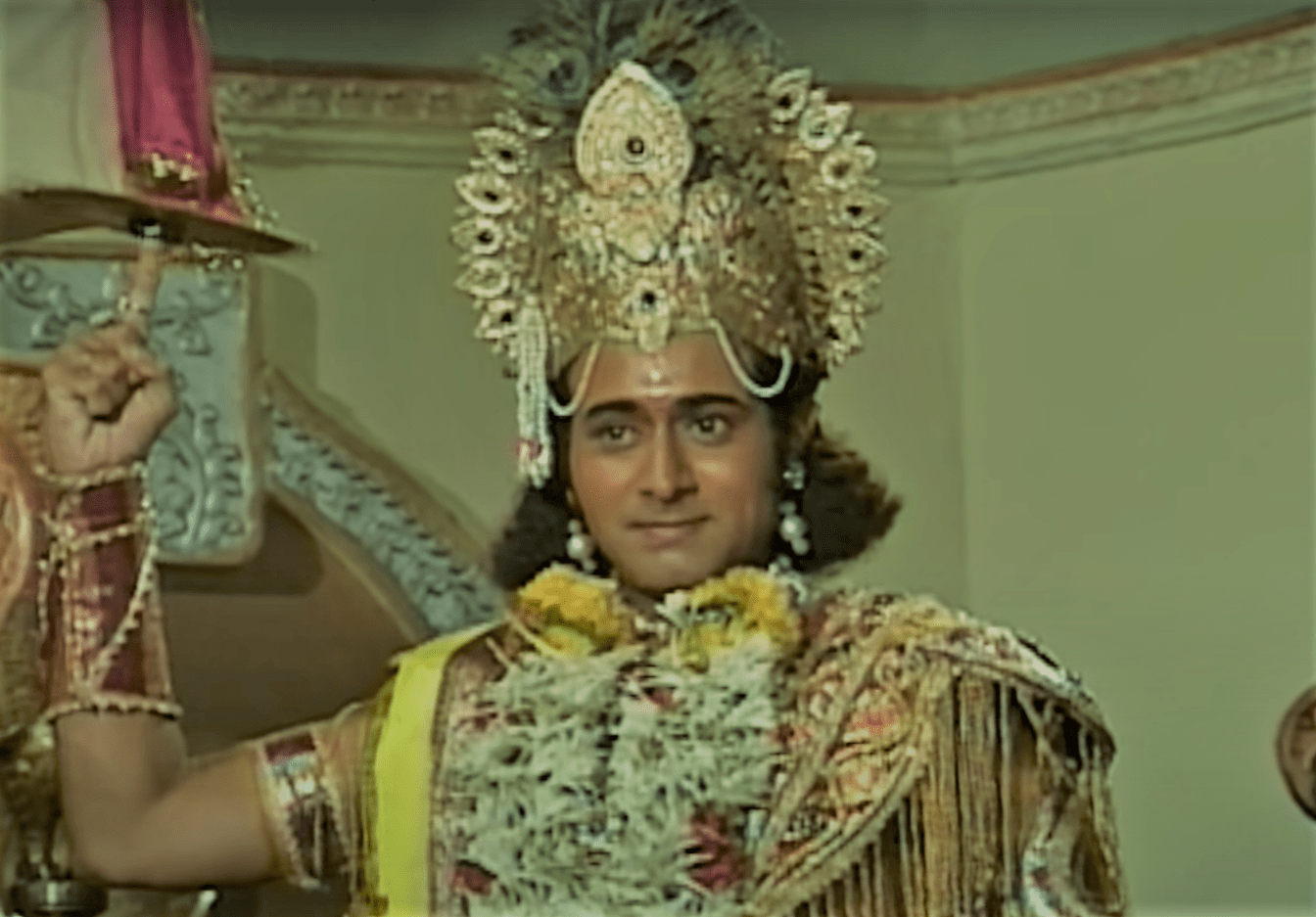
Krishna depicted in the Mahabharata tv series
Interestingly, the decision to air the Ramayana came from an avowedly “secular” government, helmed by the Congress party, which was in power at the time, and which was seeking to curry favor with Hindus during the ongoing campaign by Hindu organizations to build a temple at the site of Rama’s “birthplace” in Ayodhya, where a 16th-century mosque then stood. The airing of these mythological serials ultimately presented an opportunity to right-wing Hindu political forces led by the Bharatiya Janata Party (BJP). It won 88 seats in the 1989 general elections (it had won only two in the previous polls) and lent its support to the new coalition government, marking its arrival as a serious political contender.
The airing of these mythological serials ultimately presented an opportunity to right-wing Hindu political forces led by the BJP.
The public reception and political appropriation of the two devotional melodramas has been analysed closely by Arvind Rajagopal in his 2001 book Politics after Television: Hindu Nationalism and the Reshaping of the Public in India. According to him, the tv epics allowed the collective sharing of “a golden Hindu past” and that it was against this “perceived truth,” declared on screens Sunday after Sunday, that “the opportunity of religious nationalist mobilization was eventually seized…It was against this collective fantasy that the Birthplace of Ram movement gained its strength.” BJP leaders traversed the country to drum up support in a van dressed up to look like Rama’s chariot and just as Rama had his loyal monkey army, they had theirs – called the kar sevaks – who in 1992 demolished the offending medieval mosque with pickaxes and iron bars. They did their righteous duty, their dharma, and many Hindus rejoiced.
Today, the Hindu nationalist BJP has been in power since 2014 and the Rama Temple in Ayodhya is finally under construction. In July 2020, Prime Minister Narendra Modi offered the customary prayers to the earth – the bhoomi poojan – that mark an auspicious start to a new construction, a reminder to many of an emotive scene in the tv Ramayana, in which Rama prays to a parcel of land in his birthplace Ayodhya (a scene that does not appear in the Valmiki or Tulsidas versions of the epic). Many a Hindu soul was thus salved despite dampened moods over unemployment, economic hardship, and Chinese incursions. As for the televised epics, both have been rerun several times. Their latest telecast on the state channel came soon after Modi announced the coronavirus lockdown, which he compared to the Mahabharata war; the reruns, perhaps, were a reminder to a restive public to stick to the path of dharma, seek pride in their Hindu identity, and follow their civilizational (and political) heroes.

Narendra Modi, Hindu hero, with actors dressed as Rama and Laxman (Picture Credit: Narendra Modi’s Flickr)
So, where does this leave our actual epics? Rajagopal may have provided the answer, hidden in an aside, when he quoted an unnamed interviewee who said, “Nowadays if you ask second and third [grade] students who wrote Ramayana, the prompt reply is — [tv director] Ramanand Sagar.” Now, this may not be strictly true, since many people can probably cough up the names of Valmiki or Vyasa as the right answers, but the culturally dominant tellings of the epics, the standardized, authoritative, popularly accepted, and canonical versions, even, are to this day the neatly packaged tv serials from the 1980s.
The culturally dominant tellings of the epics, the standardized, authoritative, popularly accepted, and canonical versions, even, are to this day the neatly packaged tv serials from the 1980s.
When the Japanese filmmaker Yugo Sako and the Indian animator Ram Mohan created their animated feature film Ramayana: The Legend of Prince Rama in 1992, there was immediate backlash in India from right wing groups, who objected to their deities being reduced to “cartoons,” and blocked a theatrical release in the country. It was a rather bizarre objection, given the rich tradition of visual narratives that have always accompanied the oral and textual tellings of the Ramayana. However, this rejection of Sako’s film was an important step in establishing the Hindu right as arbiters of the Indian epic tradition. The film has since aired on tv, but that’s just because the gatekeepers eventually decided it was harmless. Today, while form per se is rarely seen as an issue worth fighting over, the ancient versions of the epics continue to be bones of contention. This is because, unlike the sanitized tv versions, they do not necessarily align with the class and gender stratifications and moral codes of modern Hindu culture.
In 2011, Delhi University, one of the best universities in India, “purged” from the history syllabus an essay titled “Three Hundred Ramayanas” by the esteemed linguist and poet A. K. Ramanujan. This was not because it lacked academic rigor but on the grounds that it hurt the “religious sentiments” of right-wing activists by referencing Buddhist, Jain, and other versions of the epic that did not fit with the popular perception. So offended were they that they waged a years-long campaign against it, brought a legal action to try to have the essay removed, and even vandalized the history department. Among the “objectionable” parts of this essay, which elucidated upon the diversity of Ramayana narratives largely by quoting from them, were verses straight from the urtext itself – Valmiki’s Ramayana – and a 12th-century Tamil version by Kampan called the Ramavataram.
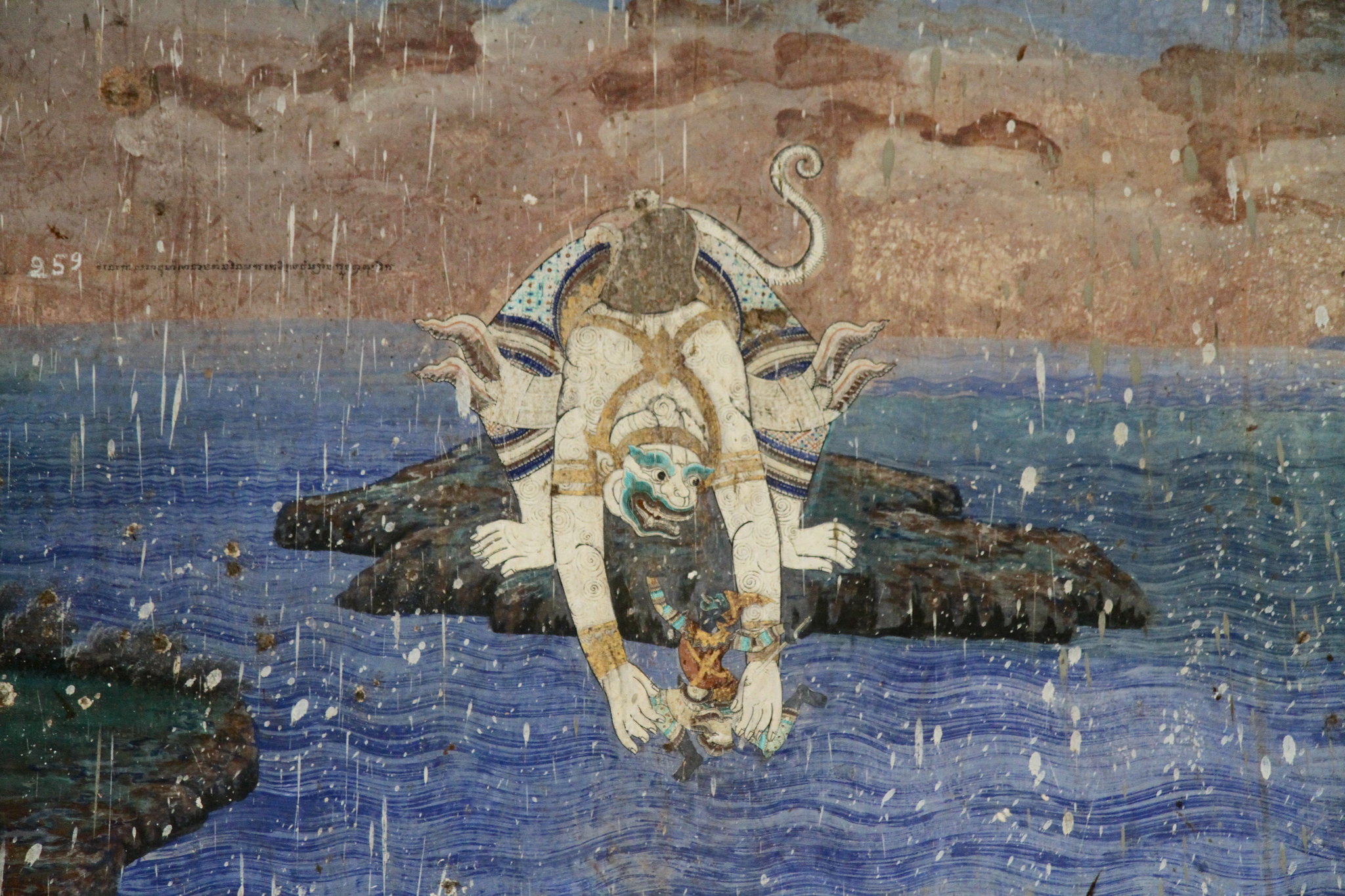
Mural in the Silver Pagoda in Phnom Penh depicting a scene from the Reamker, the Cambodian version of the Ramayana, in which the monkey king Hanuman encounters a demon while crossing the sea to Lanka (Picture Credit: Jason Eppink)
One “controversial” episode described in the essay was the story of Ahalya, the wife of the sage Gautama. In the tv version, this beautiful woman is tricked into having sex with the deity Indra, who assumes the form of her husband. The sage discovers what has happened and curses Indra with being “fruitless” and turns Ahalya into stone. After many years, Lord Rama brings her back to life because he’s a good guy, and she never meant to cheat after all.
However, in the Valmiki version, Ahalya is not quite so innocent, and thus perhaps not as worthy of redemption:
She knew it was Indra of the Thousand Eyes
in the guise of the sage. Yet she,
wrongheaded woman, made up her mind,
excited, curious about the king of the gods.
And then, her inner being satisfied, she said to the god, “I’m satisfied, king of the gods. Go quickly from here. O giver of honor, lover, protect
yourself and me.”
There are other colourful variations in this tale too. In Valmiki’s version, Indra’s testicles fall to the ground as soon as he is cursed (later replaced with those of a ram!), and in Kampan’s telling he receives a rather more creative imprecation:
“May you be covered
by the vaginas
of a thousand women!”
In the twinkle of an eye
they came and covered him.
Covered with shame,
laughing stock of the world
Indira left.
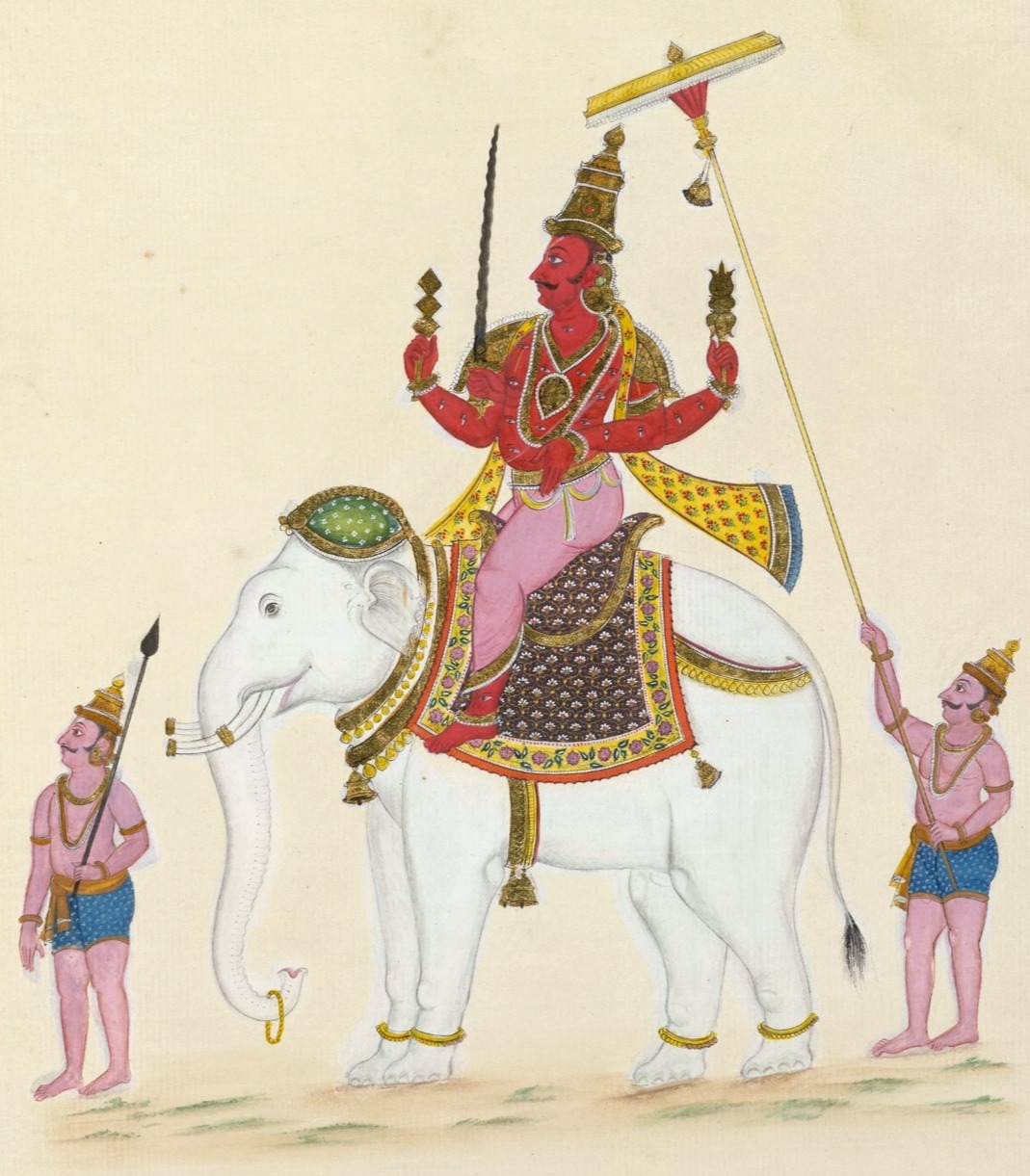
The god Indra is known as the Thousand Eyed One. In one version of the story, he was cursed with having his body covered in a thousand vaginas, which were later transformed into eyes.
These verses are not aligned with post-Victorian Hindu sensibilities, and so a movement towards their erasure, to some extent at least, became essential. Thus, the Hindu right sought to censor not Ramanujan as much as they did the sage Valmiki and the poet Kampan, implicitly ascribing more authenticity to the modern tv versions.
Parallel, and related, to the campaign for “standardization” has been the promotion of the epics as not just stories but histories that are the bedrock of Hindu identity and cannot be interpreted too freely, or at least not by the wrong kind of people (Westerners, Marxist historians, Muslims, Christians, to name a few). One former chairman, Y. Sudershan Rao, of the government-run body for historical research called for an “Indianization” of history and for collective sentiments about mythological characters to be seen as historically situated truths. In a mind-boggling argument he said: “If Rama’s story is not true then how has he survived in the collective memory for so long? People do not care whether [he] is historical or not. He is truth for them. India’s need is a special study of its past and the truth of its past cannot be denied.”
The epics have been promoted as not just stories but histories that are the bedrock of Hindu identity and cannot be interpreted too freely, or at least not by the wrong kind of people.
Since the serials of the 1980s, the two epics have become a popular and lucrative genre in Indian television and film, with six big-budget feature films based on their characters set for release this year alone. Among these are the 3D Adipurush, the futuristic and sci fi-inspired The Immortal Ashwatthama, and the fantasy action-adventure Brahmastra. These stylistic explorations are quite acceptable today, but when the film star Saif Ali Khan mentioned he’d be portraying the villain Ravana in a more sympathetic light there was an outcry. He had to apologize publicly after a petition was filed against him, never mind that several ancient versions of the Ramayana, like a 4th-century Jain version called the Paumacariya, presented Ravana as noble and virtuous but misled by passion. Today, characterizations and storylines from the epics are increasingly being promoted as immutable even though this is antithetical to their very spirit: over the centuries, both have been translated and transmuted endlessly, allowing them to cross all kinds of cultural, linguistic, and religious boundaries. There is the Dasrata Jataka with Buddhist themes and motifs (and where Rama and Sita are siblings rather than spouses), the Mappila Ramayanam with verses composed by Muslim storytellers, the Thai Ramakien where Hanuman is a ladies’ man and not celibate. If anyone dared to make a film on one of these versions in India today, they’d really have to watch their back.

A theater performance of the Ramakien, the Thai version of the Ramayana
Chindu Sreedharan, the author of Epic Retold, an anti-war reinterpretation of the Mahabharata born out of a Twitter fiction project, found that the most common criticism of his work was a “lack of factual accuracy.” “The Mahabharata is a product of co-creation, stories told from generation to generation, but now more people ascribe historicity to it and will tell you that you’re wrong if you diverge from the ‘accepted’ narrative,” he said. “I was fine doing the Twitter project and publishing Epic Retold because I live in the UK, but if I’d been in India, I might have been more nervous.” According to him, “cultivation theory” can explain the influence of the tv versions of the Mahabharata and Ramayana, and the mainstreaming of their narrative and visual tropes: “Over several decades, the dominant mass media retellings have helped shape people’s worldview, their perception of what is ‘correct’ and what is not in the epics. This viewing has taken place not in a vacuum but in historical, political, and social contexts and biases that both feed into and are fed by the mass media depictions of the Mahabharata and Ramayana,” Sreedharan said.
Does he believe that there has been a systematic erasure of “inconvenient” aspects of the urtexts as well as versions that diverge considerably in their treatment of the central characters and themes? “There may be an attempt to do so,” he said, “But it is difficult to erase the narratives that have survived for millennia. When the social and political currents change, the cultural misappropriations, too, will change. What’s happening today, against the fullness of time, is just a blip.”
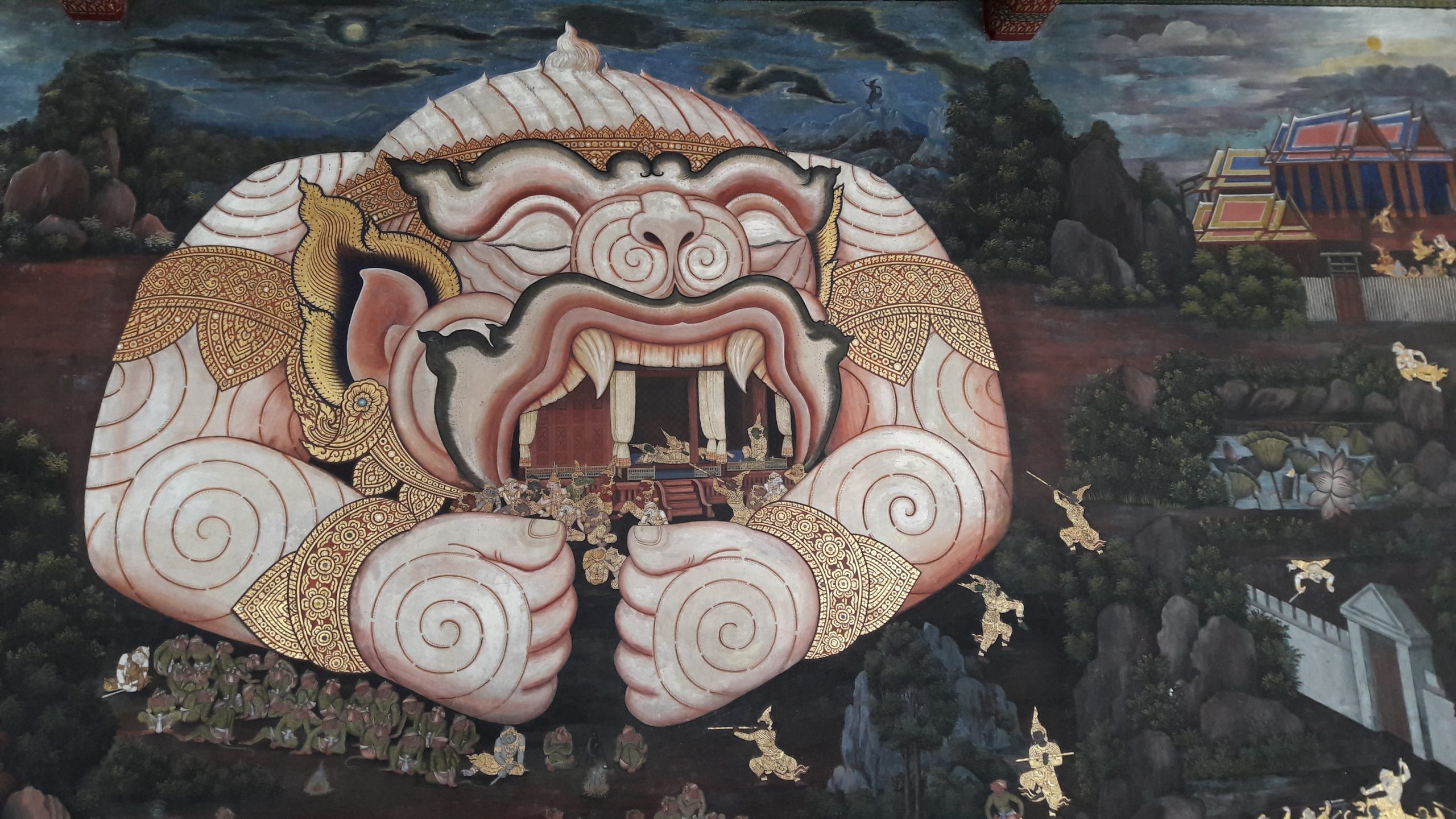
Mural in the Wat Phra Kaew (Temple of the Emerald Buddha) in Bangkok of a scene from the Ramakien, depicting Hanuman in his giant form
As Lord Krishna says sanguinely in the Bhagavad Gita, “The end and the beginning…are unknown. We see only the intervening formations. Then what cause is there for grief?”
